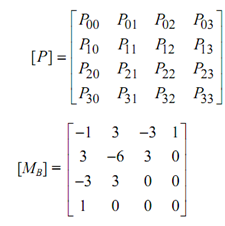Example: A 3 × 3 Bezier Surface Computation:
A cubic Bezier surface may be attained by substituting n = 3 and m = 3 in
Eqs. 19-26

0 ≤ u ≤ 1, 0 ≤ v ≤ 1
This equation may be expanded to give

= B0,3 (u) [P00 B0, 3 (v) + P01 B1, 3(v) + P02 B2, 3 (v) + P03 B3, 3 (v)]
+ B1, 3 (u) [P10 B0, 3 (v) + P11 B1, 3 (v) + P12 B2, 3 (v) + P13 B3, 3 (v)]
+ B2, 3 (u) [P20 B0, 3 (v) + P21 B1, 3 (v) + P22 B2, 3 (v) + P23 B3, 3 (v)]
+ B3, 3 (u) [P30 B0, 3 (v) + P31 B1, 3 (v) + P32 B2, 3 (v) + P33 B3, 3 (v)]
This equation may be written in a matrix form as

or

P(u, v) = UT [MB] [P] [MB]TV
where the subscript B indicate Bezier and

and the U and V vectors are [u3 u2 u 1]T respectively. Note that [MB] is the same matrix for the cubic Bezier curve.
UT [MH] [B] [MH]TV = UT [MB] [P] [MB]TV
[MH] [B] [MH] = [MB] [P] [MB]T
or Solving out for [B] gives [MH]- 1. This equation may be reduced to give

Comparing this equation along with Equation for the bicubic patch reveals that the tangent and twist vectors of the Bezier surface are expressed in terms of the vertices of its characteristic polyhedron.
